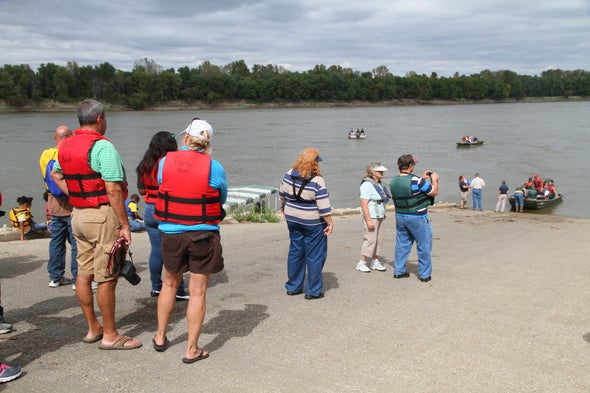
Xplor reconnects kids to nature and helps them find adventure in their own backyard. Free to residents of Missouri.


































Stay in Touch with MDC news, newsletters, events, and manage your subscription

Xplor reconnects kids to nature and helps them find adventure in their own backyard. Free to residents of Missouri.

A monthly publication about conservation in Missouri. Started in 1938, the printed magazine is free to residents of Missouri.


SPANISH LAKE, Mo.—After extensive repairs, the boat ramp to the Missouri River at Columbia Bottom Conservation Area in Spanish Lake opened again to the public last month. Fixing extensive damage from last year’s late flooding created a challenge for the Missouri Department of Conservation’s (MDC) Design and Development team. In the process however, MDC construction crews have installed measures to reduce the chance of problems in the future.
Columbia Bottom lies at the Confluence of the Missouri and Mississippi Rivers. Last December, unseasonably-heavy rains caused the Missouri River to swell its banks which breached the levee holding water back from the 4,300-acre conservation area. According to St. Louis Regional Design and Development Super Intendant Mike Norris, the levee was compromised in eight locations, each one causing damage. However, the most significant destruction was at the boat launch ramp.
“The scouring is just amazing,” Norris said. “Once it starts, the longer the high water persists, the more scouring takes place and the farther it goes, and the easier it is to continue.” He also noted that hard surfaces accelerate the process, giving the water more speed and destructive power.
The scouring severely undercut the slab under the staging/turnaround area adjacent to the boat launch ramp. The water continued on to devastate the connector road joining the boat ramp and the main road to the rest of the area. “It left a deep hole that looked like a giant moon crater; the asphalt was totally missing,” said Norris.
The first challenge facing MDC repair crews was getting to the damage in the first place. As the waters receded, they left miles of road on Columbia Bottom covered in silt and mud. These roads had to be cleared and re-rocked in order to get heavy equipment in place to do the work. MDC construction crews and Columbia Bottom staff worked together to clear the roads and get them passable again.
Repair crews determined that even though cracked, they could lift the slab safely with heavy equipment. Using an excavator to raise the slab and employ six-inch thick steel shafts to gently support it, they pumped a form of grout underneath it. “It’s like a concrete, but better able to flow,” said Norris of the grout. “You don’t have to finish it and it will flow into the voids and fill them.” The team used the grout to successfully raise and support the slab.
“We were able to save the staging area and we didn’t have to replace it,” Norris said.
Next, a large amount of rock and dirt had to be brought in to build up the ground under the connecting road. Instead of asphalt, the team poured more durable concrete to replace the road surface.
Since flooding is a natural process and has been historically common on the area, Norris and his crew sought to take measures that could reduce the chances of damage in the future.
Crews dug a vertical footing wall trench, about four feet deep and re-enforced with steel, around the staging area and along the connecting road. The goal was to prevent future undercutting. “The water should come in, hit the footing wall, and be deflected on toward the interior of the area, instead of finding a way under the road and destroying it again,” said Norris.
Columbia Bottom Conservation Area is now fully-accessible again after the flood of last December, thanks to the hard work and innovation of MDC construction crews and area staff. Norris said he was glad to be able to finally wrap the project up and open the ramp to the public again. Having also flooded in June of 2013, this is the second time in less than two years the area has incurred major flood damage and kept repair crews busy.
“I’m hoping we can go more than a year and a half without another one,” Norris said.
For more information on Columbia Bottom, go to https://nature.mdc.mo.gov/discover-nature/places/columbia-bottom-ca.